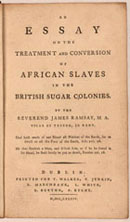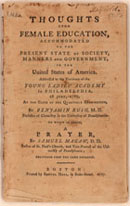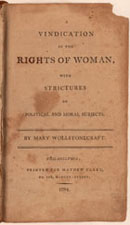 |
||
Universities and colleges were anything but inclusive. The vast majority admitted only elite, white men, of the church to which the institution’s founders belonged. This section of the exhibition examines two categories of people outside that group: Native Americans and white women. |
||
Nahua Latinists Fray Juan Bautista taught at the Franciscan Colegio of Santa Cruz de Tlatelolco, a school where young men of the Nahua elite studied Spanish and Latin and the basics of the art curriculum. A prolific author of doctrinal works, in this collection of sermons fray Juan Bautista praises his students' talents not only in helping him learn Nahuatl, but also their command of Latin. Here he commends Francisco Baptista de Contreras, Estevan Bravo, and Antonio Valeriano, “one of the best Latinists and rhetoriticians to have [graduated] (although there were many in the early years).” |
||
Colegios de caciques Tlatelolco was not the only example of colegios de caciques, schools where boys from elite indigenous families studied Latin and the traditional subjects of the arts curriculum. Peru had two, in Lima and Cuzco, both run by the Jesuit order. This document, written as part of the accounting for properties confiscated by the Jesuits at the time of their suppression, includes the statutes for the Lima colegio. |
 |
|
Origins of Dartmouth
|
||
4. “A front view of Dartmouth College, with the chapel & hall.” In: The Massachusetts magazine or monthly museum. Vol. V, no. 2 (February, 1793). As in the Spanish colonies, the English colonies early on called for educating Indian boys; unlike in the Spanish colonies, they seldom acted on it. Rev. Eleazar Wheelock opened Moor’s Indian Charity School in Connecticut in 1755. This “plain and faithful narrative,” which opened with biblical quotations praising generosity – “The liberal Soul shall be made fat, and he that watereth shall also be watered himself” (Prov. 11:25) – was one of Wheelock’s many fund-raising publications. One of his students, the Mohegan minister Samson Occom, went on a successful fund-raising expedition to England in 1766. Wheelock used the funds to expand his school into a college, relocate it to New Hampshire, and convert it (now known as Dartmouth College) into a school primarily for white men. |
||
The gospel in Mohawk Both before and after the American Revolution, the British crown developed an alliance with the Mohawk tribe, including Christian writings published in the Mohawk language, and this implicit promise of education in literacy. This translation of the Book of Common Prayer also includes a Mohawk text of the Gospel of Mark, written by the military and political leader Joseph Brant (Thayendanegea). Its frontispiece illustrates an imaginary meeting between the British king and queen and the Mohawk leaders. |
 |
|
The treatment and conversion of African slaves In contrast to the case of Native Americans, no white author in North or South America advocated extending higher education to African-descended people; even basic education for black people was often a controversial proposition. In this short treatise, an English clergyman advocated classes for reading and writing for African slaves in the Caribbean islands. |
||
The tenth muse Sor Juana Inés de la Cruz (1651-1695), a Hieronymite nun in Mexico City, was one of the great intellectuals of her age. Initially welcomed into the community of letters by male scholars, her erudition and willingness to write about theological matters (along with almost every other subject) antagonized powerful male figures in Mexican society. In 1691 the bishop of Puebla attacked her in print under the pseudonym of Sor Filotea, allegedly a fellow nun; Sor Juana responded with a passionate argument for women’s ability to freely study all subjects. Her enemies, including the Archbishop of Mexico, forced her to give up her library, and she died four years later. Her defense of women’s rights to higher education was posthumously published in a collection of her work in 1700. |
||
The Society for Propagation of the Gospel These tracts, addressed to the Anglican missionary organization the Society for Propagation of the Gospel in Foreign Parts, expressed the distinction many European authors made between Native Americans and Africans. “The quick sagacity of the Indian keeps him aloof from every attempt to convert him,” but responded well to missionaries’ educational efforts. By contrast, Knox wrote, “the dull stupidity of the Negro leaves him without any desire for instruction.” |
||
Essays on moral subjects Benjamin Rush, a Philadelphia physician who was a signer of the Declaration of Independence and the founder of Dickinson College, was the first significant advocate in North America for higher education for women. But his model for women’s education was quite different from the education men received: in his view, the most important training for women was in literature, guiding women to contribute to national conversation through poetry, essays on moral topics, and didactic history. |
||
Natural physicians The pioneering English reformer Mary Wollstonecraft argued that men’s and women’s capacities were essentially the same, although their education should differ to reflect their differing roles in society: women, for instance, as the natural physicians for their families, should study medicine and anatomy. While rejecting the misogyny of Jean-Jacques Rousseau’s influential theories of education, she agreed with his wholesale rejection of classical models, instead allowing children and adolescents to learn by following their natural instincts in reasoning and investigating the world. Wollstonecraft’s early feminism deeply influenced debates on gender in the Atlantic world, but her proposal for a national education policy for young women had little impact in her time. |
||
Cool experience This English clergyman counseled against higher education for girls in boarding schools or colleges. He argued: “Some women have encountered the abstruseness of mathematics. Others have loved to wander in the labyrinths of metaphysics. But what progress have they made? What great feats have they achieved? Let cool experience answer the question.” |
||
| To next section, Defending a Thesis. | ||
To read the entire scanned book, go to the John Carter Brown Library's Internet Archive book at this link. |
||
| the Exhibition may be seen in the reading room from April 2014 through october 2014. |

















